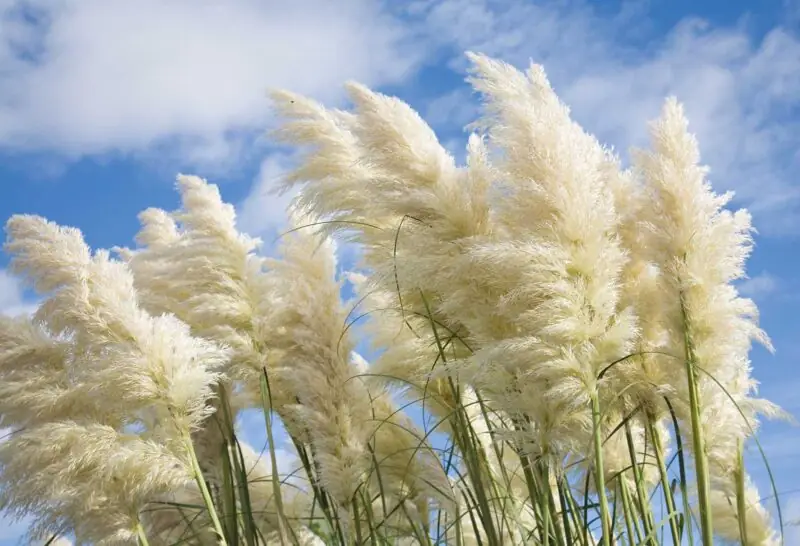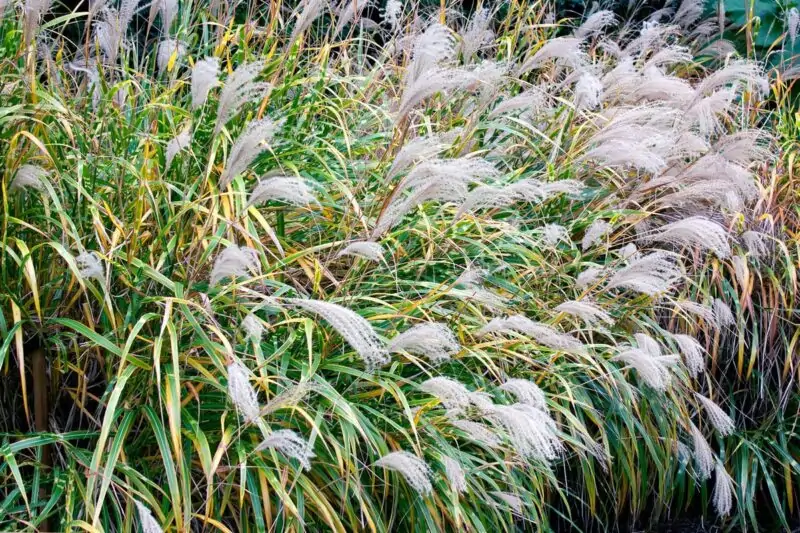Tall Ornamental Grass: Add Privacy and Texture to Your Garden with Tall Grasses

Today we’re going on an enlightening journey through the tall grasses, those often underappreciated heroes of the garden. We’re talking feather reed grass, pampas grass, bluestem, and a whole lot more. These beauties are perennial and a favorite of gardeners for their versatility, easy care, and landscape-transforming power.
The Importance and Benefits of Tall Grasses
From the ravishing ravenna grass to the modest maiden grass, tall grasses hold an irreplaceable spot in every gardener’s heart. Their perennial nature means they return year after year, rewarding your initial planting effort with seasons of enjoyment. With their full sun-loving nature and ability to thrive in a range of soil conditions, they’re every gardener’s dream!
These grasses are more than just a pretty sight. Tall grasses play a critical role in erosion control. Their extensive root systems help bind the soil together, reducing soil erosion and creating a healthier landscape. The feather-like plumes and seed heads of some varieties add an airy visual interest, enhancing the beauty of your landscape in late summer and fall.
Pampas Grass
Among the tall grasses, pampas grass stands out with its impressive stature and spectacular feathery plumes. Native to South America, it can tower up to 12 feet tall! This grass can add a touch of the exotic to any garden.
It blooms in late summer, followed by a display of feathery, silver grass plumes. This grass variety loves full sun and can tolerate a range of soil conditions, making it an adaptable addition to any garden.
Bluestem
Bluestem is another stunner in the world of tall grasses. It’s a North American native that has made its way into gardens around the globe. The bluestem grass, particularly the big bluestem, sports tall, slender stems and blue-green leaves.
This grass turns a gorgeous shade of gold in autumn, offering a warm, rustic visual appeal. And did I mention that it’s a low-maintenance plant that’s heat and humidity tolerant? So, even if your thumb isn’t the greenest, bluestem can be your go-to tall grass.
Silver Grass
Silver grass, also known as Miscanthus, is a popular choice for adding a touch of elegance to any garden. This graceful grass grows in clumps, reaching heights of 3 to 5 feet and even more in the right conditions. Imagine the gentle sway of its long, slender leaves in the breeze. It’s an enchanting sight that adds a sense of calm and tranquility to your outdoor space.
Fountain Grass
Fountain grass, with its signature arching shape, is a delight to have in the garden. Its flower spikes, resembling a water fountain, give it an aesthetic appeal that’s hard to match. This grass grows well in full sun or part shade and provides a stunning mid to late summer bloom.
Feather Reed Grass
Feather reed grass is one that catches the eye with its tall, upright growth and feathery plumes. It grows well in moist soil and creates a remarkable vertical effect in the garden. Moreover, this grass variety is deer resistant, which makes it ideal for areas with deer activity.
Maiden Grass
Maiden grass is another tall grass that’s easy to grow and offers a lovely visual spectacle. This grass has feathery seed heads that sway in the wind, creating an eye-catching display. It’s a perennial ornamental grass that can grow several inches from the ground, providing an interesting height variation in your garden.
Ravenna Grass
Ravenna grass, also known as plume grass, is a statuesque beauty. Its tall spikes covered with feathery plumes can tower up to 12 feet, making it a striking focal point in any garden. This grass variety is tolerant of a wide range of soil conditions, further enhancing its popularity among gardeners.
Zebra Grass
Zebra grass is a visual delight, with its green leaves adorned with horizontal white stripes. This variegate makes it an eye-catching addition to any landscape. Despite its exotic looks, zebra grass is easy to grow, making it a favorite among both new and experienced gardeners.
Hair Grass
Hair grass is a charming tall grass that offers a beautiful display of delicate, airy seed heads. This grass can adapt to either sun or shade, making it versatile for different garden locations. Plus, its subtle beauty can add a softening effect to your landscape design.
Blue Oat Grass
Blue oat grass stands out with its unique, blue-green foliage. This grass is a stunner in the landscape, especially when it catches the light, creating a shimmering display. It’s a low-maintenance, drought-tolerant grass, making it an excellent choice for xeriscaping.
Northern Sea Oats
Northern sea oats are a great pick if you’re looking for a grass that offers more than just good looks. This grass is loved for its interesting flat seed heads and its ability to attract wildlife, providing cover for birds and other creatures.
Dwarf Fescue
Dwarf fescue may be small, but it’s mighty in its own way. This grass variety is a great pick for small spaces, but it’s just as effective when planted en masse in larger landscapes.
Its fine texture adds a soft, lush quality to the garden, and the fact that fescue grass is one of the most drought-tolerant grasses makes it a popular choice for low-water landscapes.
Tall Grasses as a Tool for Soil Conservation

When it comes to soil conservation, tall grasses are the unsung heroes. They help reduce soil erosion with their deep-rooted system, making them an excellent choice for hilly or sloping landscapes. They are also beneficial for improving soil health, as their dense growth helps retain soil moisture and increase organic matter.
The Importance of Soil Conservation
Soil conservation is crucial for a healthy environment. It helps maintain soil fertility, promotes biodiversity, and aids in climate change mitigation. With tall grasses in your landscape, you’re not just creating a beautiful space but also contributing to the environment’s well-being.
How Tall Grasses Contribute to Soil Conservation
Tall grasses, like the bluestem or maiden grass, work diligently below the ground. Their deep roots help bind the soil together, reducing the risk of erosion. Furthermore, these grasses create a natural mulch that helps conserve soil moisture and enhance soil fertility.
The Impact of Tall Grasses on Climate Change Mitigation
Now, here’s an interesting bit. Tall grasses also play a role in climate change mitigation. It’s through a process called carbon sequestration. These grasses absorb carbon dioxide from the atmosphere and store it in their roots, helping to reduce greenhouse gases.
The Role of Grasses in Carbon Sequestration
In the fight against climate change, grasses like the big bluestem and northern sea oats are our allies. They absorb carbon dioxide during photosynthesis and store it in their roots, which helps reduce the concentration of greenhouse gases in the atmosphere.
How Tall Grasses Help Mitigate Climate Change
By capturing and storing carbon, these grasses help mitigate climate change. Plus, their adaptation to various climates and ability to survive in different soil conditions make them a sustainable choice for future landscaping and gardening practices.
Tall Grasses: An Option for Low Maintenance Landscaping
The Benefits of Low-Maintenance Landscaping
Low-maintenance landscaping saves you time and effort, which you can then use to enjoy the beauty of your garden. With tall grasses, you can have a garden that’s not only gorgeous but also kind to your schedule and the environment.
Why Choose Tall Grasses for Low Maintenance Landscaping
Tall grasses are hardy, require less water, and can thrive in various soil conditions. Their ability to withstand pests and diseases reduces the need for chemical interventions, making your garden safer and more natural.
Frequently Asked Questions
Most tall grasses thrive in full sun, but some can tolerate part shade. They’re adaptable to a wide range of soil conditions, but well-drained soil is the best. Each grass variety has specific needs, so it’s best to check the care instructions when you shop ornamental grasses.
Pruning tall grasses is generally straightforward. You cut back the old foliage to a few inches from the ground in early spring before new growth begins. This helps the plant focus its energy on producing fresh, healthy foliage.
Each type of tall grass has its unique characteristics. For example, pampas grass is known for its towering height and spectacular plumes, while zebra grass stands out with its variegated foliage. Similarly, blue oat grass is loved for its blue-green leaves, and hair grass is known for its airy, delicate seed heads.
One of the advantages of tall grasses is their resistance to pests and diseases. However, it’s always good to monitor your plants and address any issues early. If you notice changes in your grass, it’s best to visit the site of a reputable garden center or consult with a gardening expert.
Conclusion
From the aesthetic appeal of tall grasses to their role in environmental conservation, it’s clear that these plants have much to offer. Tall grasses will continue to play a vital role in both landscaping and gardening. With their low-maintenance requirements and their adaptability to different conditions, we can only expect their popularity to grow.